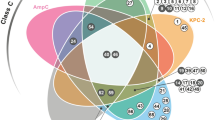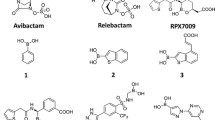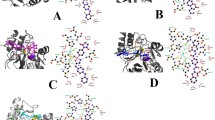Abstract
The worldwide spread of beta-lactamases with hydrolytic activity extended to last resort carbapenems is aggravating the antibiotic resistance problem and endangers the successful antimicrobial treatment of clinically relevant pathogens. As recently highlighted by the World Health Organization, new strategies to contain antimicrobial resistance are urgently needed. Class A carbapenemases include members of the KPC, GES and SFC families. These enzymes have the ability to hydrolyse penicillins, cephalosporins and carbapenems, while also being less susceptible to available beta-lactam inhibitors, such as clavulanic acid. The KPC family is the most prevalent. It is mostly found on plasmids in Klebsiella pneumoniae, meaning that great amounts of attention, in terms of inhibitor design and structural biology, have been dedicated to it, whereas no efforts have yet been dedicated to GES-type enzymes, despite their ability to rapidly and horizontally disseminate. We herein report the first in silico screening against GES-5, which is the most dangerous GES-type beta-lactamase, using a library of 800K commercially available candidates that all share drug-like properties, such as their MW, logP, rotatable bonds and HBA/HBD atoms. The best screening results were filtered to enrich the number of different chemotypes, and then submitted to molecular docking. The 34 most promising candidates were selected for in vitro validation in biochemical assays against recombinant GES-5. Six hits acted as inhibitors, in the high micromolar range, towards GES-5 and led to the identification of the first, novel chemotypes with inhibitory activity against this clinically relevant carbapenemase.





Similar content being viewed by others
References
Tondi D, Cross S, Venturelli A et al (2016) Decoding the structural basis for carbapenem hydrolysis by class A β-lactamases: fishing for a pharmacophore. Curr Drug Targets 17:983–1005. https://doi.org/10.2174/1389450116666151001104448
Cantón R, Akóva M, Carmeli Y et al (2012) Rapid evolution and spread of carbapenemases among Enterobacteriaceae in Europe. Clin Microbiol Infect 18:413–431. https://doi.org/10.1111/j.1469-0691.2012.03821.x
Naas T, Poirel L, Nordmann P (2008) Minor extended-spectrum beta-lactamases. Clin Microbiol Infect. https://doi.org/10.1111/j.1469-0691.2007.01861.x
Weldhagen GF (2006) Genetic stability of class 1 integron-borne blaGES-type genes under short-term in vitro antibiotic stress. Int J Antimicrob Agents 28:481–483. https://doi.org/10.1016/j.ijantimicag.2006.08.012
Smith CA, Nossoni Z, Toth M et al (2016) Role of the conserved disulfide bridge in class A carbapenemases. J Biol Chem 291:22196–22206. https://doi.org/10.1074/jbc.M116.749648
Smith CA, Frase H, Toth M et al (2012) Structural basis for progression toward the carbapenemase activity in the GES family of β-lactamases. J Am Chem Soc 134:19512–19515. https://doi.org/10.1021/ja308197j
Stewart NK, Smith CA, Frase H et al (2015) Kinetic and structural requirements for carbapenemase activity in GES-type β-lactamases. Biochemistry 54:588–597. https://doi.org/10.1021/bi501052t
Chihi H, Bonnin RA, Bourouis A et al (2016) GES-11-producing Acinetobacter baumannii clinical isolates from Tunisian hospitals: long-term dissemination of GES-type carbapenemases in North Africa. J Glob Antimicrob Resist 5:47–50. https://doi.org/10.1016/j.jgar.2016.03.005
Bonnin RA, Jousset AB, Urvoy N et al (2017) Detection of GES-5 carbapenemase in Klebsiella pneumoniae, a newcomer in France. Antimicrob Agents Chemother 61:e02263–e02216. https://doi.org/10.1128/AAC.02263-16
Poirel L, Le Thomas I, Naas T et al (2000) Biochemical sequence analyses of GES-1, a novel class A extended-spectrum beta-lactamase, and the class 1 integron In52 from Klebsiella pneumoniae. Antimicrob Agents Chemother 44:622–632. https://doi.org/10.1128/AAC.44.3.622-632.2000
http://bldb.eu/BLDB.php?prot=A#GES. Accessed July 2018
Pedersen T, Sekyere JO, Govinden U et al (2018) Spread of plasmid-encoded NDM-1 and GES-5 carbapenemases among extensively drug-resistant and pandrug-resistant clinical enterobacteriaceae in durban, South Africa. Antimicrob Agents Chemother 62:e02178–e02117. https://doi.org/10.1128/AAC.02178-17
Castillo-Vera J, Ribas-Aparicio RM, Nicolau CJ et al (2012) Unusual diversity of acquired β-lactamases in multidrug-resistant Pseudomonas aeruginosa Isolates in a Mexican Hospital. Microb Drug Resist 18:471–478. https://doi.org/10.1089/mdr.2011.0183
Viedma E, Juan C, Acosta J et al (2009) Nosocomial spread of colistin-only-sensitive sequence type 235 Pseudomonas aeruginosa isolates producing the extended-spectrum β-lactamases GES-1 and GES-5 in Spain. Antimicrob Agents Chemother 53:4930–4933. https://doi.org/10.1128/AAC.00900-09
Smith CA, Caccamo M, Kantardjieff KA, Vakulenko S (2007) Structure of GES-1 at atomic resolution: insights into the evolution of carbapenamase activity in the class A extended-spectrum β-lactamases. Acta Crystallogr D 63:982–992. https://doi.org/10.1107/S0907444907036955
Santucci M, Spyrakis F, Cross S et al (2017) Computational and biological profile of boronic acids for the detection of bacterial serine- and metallo-β-lactamases. Sci Rep 7:17716. https://doi.org/10.1038/s41598-017-17399-7
Spyrakis F, Celenza G, Marcoccia F et al (2017) Structure-based virtual screening for the discovery of novel inhibitors of New Delhi metallo-β-lactamase-1. ACS Med Chem Lett 9:45–50. https://doi.org/10.1021/acsmedchemlett.7b00428
Baroni M, Cruciani G, Sciabola S et al (2007) A common reference framework for analyzing/comparing proteins and ligands. fingerprints for ligands and proteins (FLAP): theory and application. J Chem inf Model 47:279–294. https://doi.org/10.1021/ci600253e
Spyrakis F, Cellini B, Bruno S et al (2014) Targeting cystalysin, a virulence factor of Treponema denticola-supported periodontitis. ChemMedChem 9:1501–1511. https://doi.org/10.1002/cmdc.201300527
Spyrakis F, Singh R, Cozzini P et al (2013) Isozyme-specific ligands for O-acetylserine sulfhydrylase, a novel antibiotic target. PLoS ONE 8:e77558. https://doi.org/10.1371/journal.pone.0077558
Milletti F, Storchi L, Goracci L et al (2010) Extending pKa prediction accuracy: high-throughput pK a measurements to understand pKa modulation of new chemical series. Eur J Med Chem 45:4270–4279. https://doi.org/10.1016/j.ejmech.2010.06.026
Spyrakis F, Felici P, Bayden AS et al (2013) Fine tuning of the active site modulates specificity in the interaction of O-acetylserine sulfhydrylase isozymes with serine acetyltransferase. Biochim Biophys Acta: Proteins Proteom 1834:169–181. https://doi.org/10.1016/j.bbapap.2012.09.009
Wade RC, Goodford PJ (1989) The role of hydrogen-bonds in drug binding. Prog Clin Biol Res 289:433–444. https://doi.org/10.1007/0-387-29148-2_2
Quotadamo A, Linciano P, Davoli P et al (2016) An improved synthesis of CENTA, a chromogenic substrate for β-lactamases. Synlett 27:2447–2450. https://doi.org/10.1055/s-0035-1562454
Feng BY, Shoichet BK (2006) A detergent-based assay for the detection of promiscuous inhibitors. Nat Protoc 1:550–553. https://doi.org/10.1038/nprot.2006.77
Yung-Chi C, Prusoff WH (1973) Relationship between the inhibition constant (KI) and the concentration of inhibitor which causes 50 per cent inhibition (I50) of an enzymatic reaction. Biochem Pharmacol 22:3099–3108. https://doi.org/10.1016/0006-2952(73)90196-2
Spyrakis F, Benedetti P, Decherchi S et al (2015) A pipeline to enhance ligand virtual screening: integrating molecular dynamics and fingerprints for ligand and proteins. J Chem Inf Model 26:2256–2274. https://doi.org/10.1021/acs.jcim.5b00169
Krishnan NP, Nguyen NQ, Papp-Wallace KM et al (2015) Inhibition of Klebsiella β-lactamases (SHV-1 and KPC-2) by avibactam: a structural study. PLoS ONE 10:e0136813. https://doi.org/10.1371/journal.pone.0136813
Celenza G, Vicario M, Bellio P et al (2018) Phenylboronic acid derivatives as validated leads active in clinical strains overexpressing KPC-2: a step against bacterial resistance. ChemMedChem 13:713–724. https://doi.org/10.1002/cmdc.201700788
Tondi D, Venturelli A, Bonnet R et al (2014) Targeting class A and C serine β-lactamases with a broad-spectrum boronic acid derivative. J Med Chem 57:5449–5458. https://doi.org/10.1021/jm5006572
Farina D, Spyrakis F, Venturelli A et al (2014) The inhibition of extended spectrum β-lactamases: hits and leads. Curr Med Chem 21:1405–1434. https://doi.org/10.2174/09298673113206660323
Genovese F, Lazzari S, Venturi E et al (2017) Design, synthesis and biological evaluation of non-covalent AmpC β-lactamases inhibitors. Med Chem Res 26:975–986. https://doi.org/10.1007/s00044-017-1809-x
Klein R, Linciano P, Celenza G et al (2018) In silico identification and experimental validation of hits active against KPC-2 β-lactamase. PLoS ONE 13:e0203241. https://doi.org/10.1371/journal.pone.0203241
Strynadka NCJ, Adachi H, Jensen SE et al (1992) Molecular structure of the acyl-enzyme intermediate in β-lactam hydrolysis at 1.7 Å resolution. Nature 359:700–705. https://doi.org/10.1038/359700a0
Swarén P, Maveyraud L, Raquet X et al (1998) X-ray analysis of the NMC-A beta-lactamase at 1.64-A resolution, a class A carbapenemase with broad substrate specificity. J Biol Chem 273:26714–26721. https://doi.org/10.1074/JBC.273.41.26714
Sougakoff W, L’Hermite G, Pernot L et al (2002) Structure of the imipenem-hydrolyzing class A β-lactamase SME-1 from Serratia marcescens. Acta Crystallogr D 58:267–274. https://doi.org/10.1107/S0907444901019606
Fonseca F, Chudyk EI, Van Der Kamp MW et al (2012) The basis for carbapenem hydrolysis by class a beta-lactamases: a combined investigation using crystallography and simulations. J Am Chem Soc 134:18275–18285. https://doi.org/10.1021/ja304460j
Babaoglu K, Simconov A, Irwin JJ et al (2008) Comprehensive mechanistic analysis of hits from high-throughput and docking screens against β-lactamase. J Med Chem 51:2502–2511. https://doi.org/10.1021/jm701500e
Tondi D, Morandi F, Bonnet R et al (2005) Structure-based optimization of a non-beta-lactam lead results in inhibitors that do not up-regulate beta-lactamase expression in cell culture. J Am Chem Soc 127:4632–4639. https://doi.org/10.1021/ja042984o
Zhu T, Cao S, Su PC et al (2013) Hit identification and optimization in virtual screening: practical recommendations based on a critical literature analysis. J Med Chem 56:6560–6572. https://doi.org/10.1021/jm301916b
Balakin KV, Savchuk NP, Tetko IV (2006) In silico approaches to prediction of aqueous and DMSO solubility of drug-like compounds: trends, problems and solutions. Curr Med Chem 13:223–241. https://doi.org/10.2174/092986706775197917
Tondi D, Powers RA, Caselli E et al (2001) Structure-based design and in-parallel synthesis of inhibitors of AmpC β-lactamase. Chem Biol 8:593–611. https://doi.org/10.1016/S1074-5521(01)00034-5
Venturelli A, Tondi D, Cancian L et al (2007) Optimizing cell permeation of an antibiotic resistance inhibitor for improved efficacy. J Med Chem 50:5644–5654. https://doi.org/10.1021/jm070643q
Tondi D, Calò S, Shoichet BK, Costi MP (2010) Structural study of phenyl boronic acid derivatives as AmpC β-lactamase inhibitors. Bioorg Med Chem Lett 20:3416–3419. https://doi.org/10.1016/j.bmcl.2010.04.007
Acknowledgements
We kindly acknowledge Molecular Discovery Ltd for providing the FLAP software and for supporting GD. We thank Prof. Sergei Vakulenko (University of Notre Dame du Lac, Indiana, USA) for the generous gift of the blaGES-5 gene, k cloned in pet24a(+), and Dr. Dale J.M. Lawson for critically reading the manuscript.
Funding
The project was funded by a Fondo di Ricerca di Ateneo (Grant No. FAR2014) UNIMORE grant to Donatella Tondi.
Author information
Authors and Affiliations
Corresponding authors
Additional information
Publisher’s Note
Springer Nature remains neutral with regard to jurisdictional claims in published maps and institutional affiliations.
Electronic supplementary material
Below is the link to the electronic supplementary material.
Rights and permissions
About this article
Cite this article
Spyrakis, F., Bellio, P., Quotadamo, A. et al. First virtual screening and experimental validation of inhibitors targeting GES-5 carbapenemase. J Comput Aided Mol Des 33, 295–305 (2019). https://doi.org/10.1007/s10822-018-0182-2
Received:
Accepted:
Published:
Issue Date:
DOI: https://doi.org/10.1007/s10822-018-0182-2




